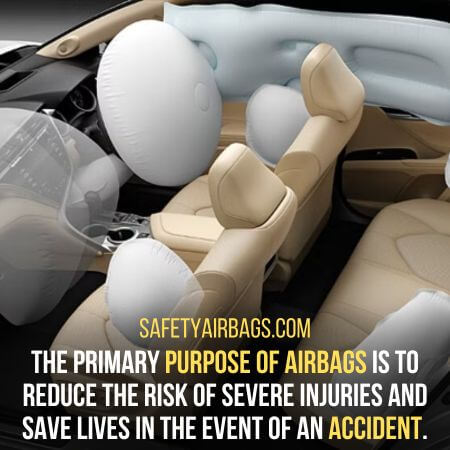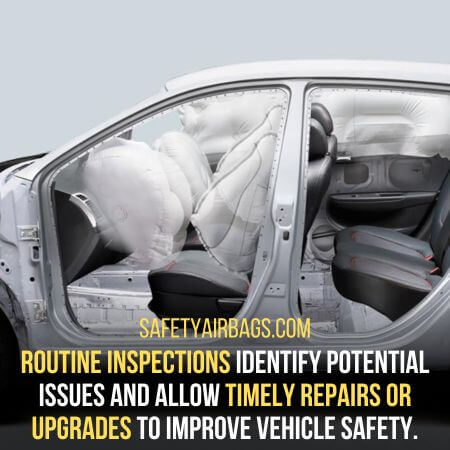Is it bad to drive without an airbag? Airbags are safety devices installed in vehicles to protect occupants during collisions.
What Will I learn
- 1 Is It Bad To Drive Without An Airbag?
- 2 The Purpose and Function of Airbags
- 3 The Importance of Airbags in Vehicle Safety
- 4 Risks and Consequences of Driving Without Airbags
- 5 Legal and Regulatory Requirements for Airbags
- 6 Factors Contributing to the Absence of Airbags in Vehicles
- 7 Alternatives and Mitigation Strategies for Vehicles without Airbags
- 8 Public Awareness and Education on Airbag Safety
- 9 Conclusion:
They are designed to rapidly inflate upon impact and act as a cushioning barrier between the occupants and the hard surfaces of the vehicle’s interior.
Is It Bad To Drive Without An Airbag?
Driving without an airbag can increase the risk of injury or fatality in the event of an accident.
Airbags work in conjunction with seat belts to provide optimal safety.

While seat belts alone are effective at preventing ejections and reducing the risk of severe injuries, airbags can further mitigate the impact forces on the body during a collision.
They deploy rapidly upon detecting a crash and act as a buffer between the occupants and the hard surfaces within the vehicle.
Driving without an airbag is not recommended because it removes an important safety feature specifically designed to protect occupants in the event of a crash.
However, it’s worth noting that airbags are not the only safety measure in a vehicle.
Other safety features like seat belts, anti-lock braking systems (ABS), and crumple zones contribute to overall safety.
The Purpose and Function of Airbags
The primary purpose of airbags is to reduce the risk of severe injuries and save lives in the event of an accident.
Airbags are safety devices installed in vehicles designed to deploy rapidly during collisions.
They are typically made of a thin, strong fabric and are located in various parts of the vehicle’s interior, including the steering wheel, dashboard, side panels, and roof.
Airbags act as a supplemental restraint system, working with seat belts to enhance vehicle occupants’ protection.
When a collision occurs, airbags are triggered by sensors that detect the impact and send signals to the airbag control unit.
The control unit then activates the airbag inflator, which rapidly fills the airbag with gas.
This inflation process occurs within milliseconds, allowing the airbag to deploy and create a cushioning effect that helps absorb and distribute the impact forces.
As a result, airbags help to reduce the risk of occupants’ heads, chests, and other body parts from striking hard surfaces within the vehicle.
The Importance of Airbags in Vehicle Safety
Airbags play a crucial role in reducing the severity of injuries during collisions.
They provide additional protection as a supplemental safety measure to seat belts.
Airbags help absorb and distribute the impact forces when a collision occurs, reducing the risk of occupants sustaining severe head, chest, or upper body injuries.
Studies have shown that vehicle airbags significantly decrease the likelihood of fatal or life-threatening injuries, making them a vital component of vehicle safety.
Complementary Relationship Between Airbags and Seat Belts:
Airbags and seat belts work together synergistically to enhance occupant safety.
While seat belts restrain occupants and prevent them from being thrown forward, airbags protect them from secondary impacts.

Seat belts hold occupants in position, ensuring they are properly positioned to benefit from airbag deployment.
This complementary relationship between airbags and seat belts minimizes the risk of occupants’ heads and bodies striking hard surfaces within the vehicle.
The Role of Airbags in Protecting Occupants During Rollovers:
Rollover accidents pose a significant risk to vehicle occupants due to the potential for multiple impacts with various surfaces.
Airbags are particularly crucial in these situations as they protect multiple directions.
Curtain or head airbags, in particular, deploy from the roof area.
They help to prevent head injuries by creating a cushioning effect and maintaining a protective space between occupants’ heads and the vehicle’s roof during a rollover event.
This added protection can significantly reduce the risk of head and neck injuries during rollovers.
Airbags and Their Impact on Child Safety:
Airbags also play a vital role in child safety. It is important to note that the deployment force of airbags is designed for adult occupants.
As a result, it is crucial to follow recommended guidelines for child restraint systems and seating positions.
Children should be properly secured in age–appropriate child safety seats, and rear-facing seats should never be placed in the front seat with an active airbag.
Risks and Consequences of Driving Without Airbags
Driving without airbags significantly increases the risk of sustaining severe injuries during collisions.
Airbags provide a cushioning effect that helps to absorb and distribute the impact forces, reducing the likelihood of occupants striking hard surfaces within the vehicle.
Without this protection, occupants are more vulnerable to direct impact, leading to head injuries, chest trauma, fractures, and other severe injuries.
Higher Likelihood of Fatalities in Accidents Without Airbags
The absence of airbags in a vehicle substantially increases the chances of fatalities in accidents.
Airbags are designed to mitigate the severity of injuries and increase survival rates by reducing the impact forces on occupants.
Studies have shown that airbags can significantly decrease the risk of fatal injuries, making them crucial in saving lives during accidents.
Legal and Regulatory Requirements for Airbags
Many countries have implemented mandatory airbag regulations to enhance vehicle safety standards.

These regulations require manufacturers to install airbag systems in specific locations within vehicles, such as the driver and front passenger areas.
The specific requirements may vary by country, but the overarching goal is to ensure that vehicles provide adequate occupant protection during collisions.
The Role of Regulatory Bodies in Ensuring Airbag Safety Standards:
Regulatory bodies play a crucial role in enforcing airbag safety standards.
They establish and monitor compliance with regulations, conduct testing and certification processes, and investigate potential airbag safety issues.
By overseeing these aspects, regulatory bodies strive to maintain the integrity and effectiveness of airbag systems, promoting safer driving conditions for all road users.
Factors Contributing to the Absence of Airbags in Vehicles
Here are all the factors that contribute to the absence of airbags, and therefore, avoid them:
1. Older Vehicle Models Lacking Airbag Systems:
One contributing factor to the absence of airbags in vehicles is the prevalence of older models manufactured before airbags became a standard safety feature.
These vehicles were designed and produced when airbag systems were not widely implemented.
Retrofitting them with airbags can be technically challenging or cost-prohibitive.
2. Economic Factors and Affordability of Airbag-Equipped Vehicles:
The affordability of airbag-equipped vehicles is another factor that can contribute to their absence.
In some cases, budget constraints may lead individuals to opt for older or lower-cost vehicles not equipped with airbags.
Economic considerations and purchasing decisions can influence the prevalence of vehicles without airbags on the road.
3. Challenges in Retrofitting Airbags to Older Vehicles:
Retrofitting airbags on older vehicles can be challenging due to technological compatibility issues and the need for specialized knowledge and equipment.
It may not always be feasible or cost-effective to retrofit airbags into older models, especially if the vehicle’s design or structural integrity does not support installing airbag systems.
Alternatives and Mitigation Strategies for Vehicles without Airbags
Regular vehicle maintenance and safety inspections are crucial for vehicles without airbags.
Ensuring that other safety features, such as seat belts and braking systems, are in optimal working condition can help mitigate the risks associated with the absence of airbags.
Routine inspections can identify potential issues and allow timely repairs or upgrades to improve vehicle safety.

One effective mitigation strategy is upgrading to a newer vehicle equipped with airbag systems.
By investing in a vehicle with modern safety features, including advanced airbag technologies, occupants can significantly enhance their protection during collisions.
When considering a new vehicle purchase, prioritizing safety features like airbags should be a top consideration.
Public Awareness and Education on Airbag Safety
Public awareness and airbag safety education are crucial to promoting safer driving practices.
Educating drivers about the risks and consequences of driving without airbags is essential, emphasizing the significant role that airbags play in reducing injuries and fatalities during collisions.
By increasing awareness, drivers can make informed decisions about vehicle safety features and take proactive steps to prioritize their safety and the safety of their passengers.
Collaboration Between Automobile Manufacturers, Government Agencies, and Safety Organizations:
Collaboration between automobile manufacturers, government agencies, and safety organizations is essential in raising public awareness about airbag safety.
By working together, these entities can develop educational campaigns, disseminate information, and promote the importance of airbags as a critical component of vehicle safety.
Such collaborations can significantly impact reaching a wider audience and ensuring that accurate and accessible information is available to drivers.
Promoting Safe Driving Habits and Responsible Vehicle Ownership:
Public awareness initiatives should also promote safe driving habits and responsible vehicle ownership.
Emphasize the importance of regular vehicle maintenance, following traffic laws, and prioritizing safety features like airbags.
This can encourage drivers to make informed choices that prioritize their well-being and those of others on the road.
By fostering a culture of safety, the risks associated with driving without airbags can be minimized.
Conclusion:
Airbags play a vital role in vehicle safety by reducing the severity of injuries and increasing the chances of survival during collisions.
They provide a cushioning effect that helps absorb and distribute impact forces, protecting vehicle occupants from severe head, chest, and upper body injuries.
The risks and consequences of driving without airbags are significant, increasing the likelihood of severe injuries and fatalities during accidents.
The absence of airbags particularly affects vulnerable occupants, such as children and older people.
Drivers need to prioritize their safety and the safety of their passengers by ensuring the presence of functioning airbags in their vehicles.
This can be achieved through regular vehicle maintenance, upgrading to newer vehicles with airbag systems, or considering aftermarket airbag installations where feasible.
